Torrezno Entertainment's Luis Izquierdo Juez – Myths, monsters and surprising monastic pursuits in Legends of Castile
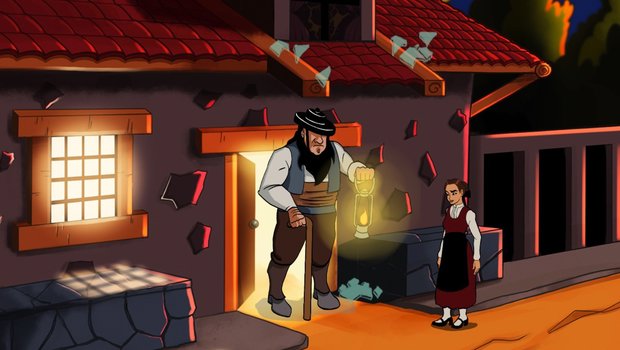
- 0 Comments
Lots of things serve as motivation for adventure game protagonists: solving crimes, searching for missing loved ones, maybe even saving the world and getting the girl (or guy) before dinner. What you don’t see often is the quest to… become a nun?! Unusual, yes, but rather than study, prayer, and extended vows of silence, there’s a whole lot more to Legends of Castile, an upcoming classic-styled adventure from Torrezno Entertainment. In fact, solo Spanish developer Luis Izquierdo Juez has drawn primarily from Spanish legend and lore for his debut adventure about a young novitiate traveling the country in search of fantastic mythological creatures.
To help finance the game inspired by genre classics like Broken Sword, Luis has launched a Kickstarter campaign for Legends of Castile, which ends November 28th and is oh-so-close to its goal but needs one last push to make it a success in the final few days. With time of the essence, I recently caught up with Luis to chat more about the game and his thought processes behind it, and I’m sure you’ll come away feeling inspired to check out the playable demo if you haven’t already, with just enough time to spare to become a crowdfunding backer if you like what you see.
Hi Luis, and welcome to the Adventure Game Hotspot. It’s always a particular thrill for me to introduce promising new developers with great-looking first games in the works. Before we talk about yours, who is Luis Izquierdo Juez, aka solo developer Torrezno Entertainment?
Luis Izquierdo Juez: Hi. First of all, I have to say that I’m truly delighted to be interviewed here. Your website is a reference for the adventure game community.
About me: I’m Luis, born in 1985 in a little town called Aranda de Duero in the province of Burgos, Spain. Shortly after, my family moved to a bigger town in the heart of Castile called Valladolid. I grew up very happily with my parents and my brother in the nineties, playing every adventure game we could find. Usually, I played the games and read the dialogues to my little brother while he gave me ideas to solve the puzzles. I learned how to use a computer with my father (and how to assemble one!) and spent as much time as I could drawing.
As an adult, I graduated as a technical telecommunications engineer, which allowed me to build a career in programming. I continued drawing and took some art classes along the way. This is why I consider myself half an artist, half an engineer.
I always love hearing about the truly international nature of the adventure game community. Is the genre popular in Spain?
Luis: It definitely is! We grew up playing most of the games I’m sure we are all thinking about, especially those from LucasArts, but also some Spanish classics like Runaway, Hollywood Monsters, or Mortadelo and Filemón games.
Most people in Spain love adventure games from the nineties very much, and they also appreciate a good Spanish translation. It's crucial to connect better with the games. So here’s my request to the rest of the adventure makers: the Spanish public needs translations, at the very least!
How did you come to be an adventure game fan, and then ultimately a developer of one yourself?

Luis: Well, like many children of the nineties, I discovered my first computer in the early part of the decade. Some floppy disks that someone lent to my father at work ended up in my hands, and the magic began: I could walk around Mêlée Island, Ankh-Morpork (Discworld), or even a strange mansion with alien tentacles, without leaving my home!
Becoming an indie game developer has been a relatively new dream for me. Don’t get me wrong, I always dreamed of it, but it seemed like a chimera because I thought it wasn’t possible to make a game on my own. Before game engines emerged, making a game implied creating your own engine, which sounded pretty intimidating to me. Additionally, I felt that my art skills weren’t up to the challenge.
That’s what I thought until 2022, when I started listening to a Spanish podcast about adventure games called Point and Click Podcast. Through this, I discovered their Discord channel, where fans and adventure game creators talk every day about playing and making adventure games, which is awesome. I remember someone discussing game engines and a new game called A Twisted Tale in development, which was being made by a solo developer (Eva-Ramona Rohleder) who I now consider a friend! That’s when I thought: What if...? And that’s how I began my journey to becoming a developer.
Like so many other aspiring new developers who have impressed us with dazzling debuts, you’ve set your sights high for your very first game.
Luis: Well, that means I’m doing good marketing for the game! Actually, I’m very aware that this is my very first game, and that’s why I tell myself every day to keep my feet on the ground. My ultimate goal with this game is to make a good adventure game that people can enjoy as much as I do creating it.
If they learn some Spanish folklore and mythology in the process, it will be worth every minute of it.
Apart from that, I've made some decisions to keep the scope of the game reasonable for my first project, like not including multiple paths or having multiple endings.
Tell us about Legends of Castile.
Luis: Legends of Castile is the adventure game I’d have loved to play in the late nineties, when legendary point-and-click adventures like The Curse of Monkey Island and Broken Sword came out. I love that 2D cartoon/realistic style you could also see in 2D Disney movies like The Hunchback of Notre Dame, Aladdin, or Hercules.
In the game, which is set in 19th century Spain in the historical region of Castile, you’ll play as María de Salazar, a young and brave village girl. One day, while having fun with her friends in a wine cellar, she steps outside for reasons related to drinking large amounts of delicious Spanish wine. Suddenly, she has a vision of the Virgin Mary, after which she decides that her only dream in life is to become a nun!
Shortly after, María goes to a monastery in Burgos and asks the Mother Superior to be ordained as a nun. However, the abbess, who has known María since she was a child, doesn’t take her seriously and commissions her an unusual and probably impossible task to perform as a postulant before becoming fully a nun: she will have to investigate the mythological creatures that have been appearing around the territory of Castile and collect an item from each to prove their existence.
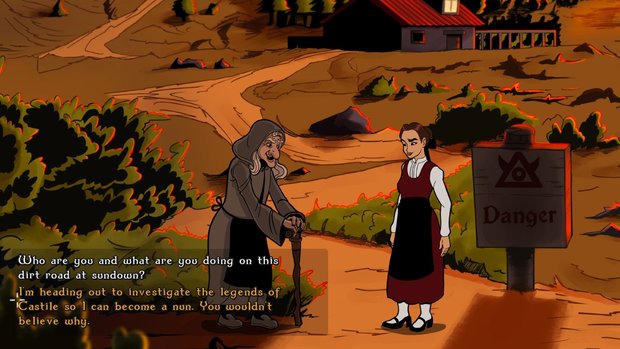
The game sticks close to home in terms of where it takes place. I know (and by “know” I mean I looked it up because I actually know embarrassingly little about Spain) that the Kingdom and later County of Castile were real places in Spanish history. Is it based on any particular real-world places?
Luis: The game is mostly based on the northern part of Castile, which is now called Castile and León. Castile has been a very changeable territory depending on the century, at times covering most of Spain, so I decided to focus on the part of Castile I know best.
This game is dedicated to the villages of Castile, so you will recognize some real villages from Spain like Aranda de Duero (Burgos), or Peñafiel (Valladolid). Considering that the mythological legends in the game are stories from real places, these places are represented in the game. You'll find one of the most amazing monasteries in Spain, underground wine cellars, a cave with a treasure, a mysterious lagoon, a cemetery, and more.
Why the 19th century?
Luis: When I was doing some research for the story, I read dozens of Castilian mythological legends in books, websites, podcasts... but then I found one that completely captivated me. This legend had the potential to be the final legend of the game. What’s even more interesting is that it appeared in a real written document from that period, claiming the legend was real! When I read this, I made up my mind and set the game's time period around that special legend, building the story from that foundation.
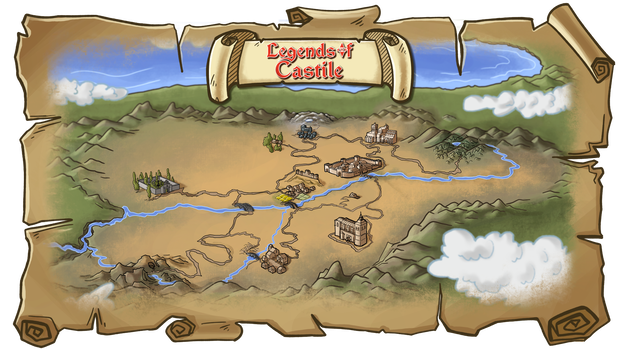
The game certainly has an unusual premise. Why make your protagonist a wannabe nun?
Luis: The story of adventure games is full of typical hero journeys starting with phrases like “I wanna be a pirate,” but what if the premise was a little more unexpected? Who could possibly have that particular dream? María de Salazar.
When I was looking for the protagonist of my story, I thought of traditionally known Spanish characters from folklore, like an apothecary, a card player, a bullfighter… but then I considered that many people in Spain had to spend part of their lives as religious individuals to be able to study if their family was humble (this happened in my own family). Being a nun was a possibility. That’s how I thought of an aspiring nun.
I’m sure there would be far fewer nuns in the world if the job application said “prove the existence of mythological creatures.” THAT sounds more like an adventure game protagonist.
Luis: María de Salazar took the challenge that her Mother Superior gave her like most things she does: without thinking too much about them. This, of course, gives me the opportunity to narrate her journey across Castile, looking for these mythological creatures and stories, while her own story unfolds. My intention in the game is to weave these little stories or legends into the narrative, with María's quest tying it all together in a single cohesive experience.

You’ve made a point of noting that while María is young and fearless, she’s also “clumsy.” How does that factor into her journey?
Luis: When I say that María is a little clumsy, I mean that sometimes she does things without thinking too much about the consequences. She is a very determined and brave young woman, but not a very sensible one. This can sometimes lead to problems for her, and she can end up in trouble because of that.
What are some of the Spanish folk legends you’ve drawn on for your game?
Luis: I can tell you about some of the legends I have already shared with the game fans, like the two that appear in the game demo. These are the “Ojaranco,” a semi-giant cyclops from the Segovia region, and the Lil enemies (“Enemiguillos”), which are familiar imps from the Burgos region.

Luis: Apart from these two, I can tell you about the Zarrampla, a female ogre who loves to eat honey... and kids. This mythological creature comes from the Valladolid region. I’m very familiar with it because, during the local festivities of Valladolid, a giant representation of this ogre, in both male and female forms, known as the “Tragaldabas” and the “Tía Melitona,” is placed in every neighborhood. Children can enter through the monster's mouth, slide down a slide, and get out from the back part of the monster.
Another legend I’ve shared is about the Cucurrumachos. These creatures from the Ávila region originate from a carnival masquerade with Celtic roots. They appear as creatures dressed in reused blankets, featuring a mix of animal skulls and horse hairs.
So on the one hand, the game has roots in the Catholic Church, correct? And on the other it has fantastical mythological creatures that clearly do not. How do you square those two seemingly conflicting elements to make them comfortably co-exist?

Luis: Yes, in Spain we are Catholic. However, I want to make it clear that the game isn't a religious game. Religion will be part of the overall story, and there will be an important plot element related to it in the last third of the game. But for most of the game, María will be investigating these mythological legends. This blend of religion and myths was inspired by playing the Broken Sword games, which I love very much. I had to create a story with those elements because I find them incredibly interesting.
Wading into overtly religious waters has been known to cause trouble. Is that why you’re playing it all for laughs?
Luis: As a creator, I’m well aware of this, and I can say that even if the game has a strong comedic element, religion will be treated with respect. Even though I’m not currently a practicing Christian, I love to visit religious places like churches or monasteries when I travel. You can learn a lot about the folklore of a country when visiting religious places, and that is not at odds with being respectful to religion and religious people.
All this plays out in a fairly traditional point-and-click fashion?
Luis: Count on it, Legends of Castile is a classic point-and-click adventure, and most of the puzzles will be inventory-based. The interface of the game is a one-click interface with three contextual verbs in a verb coin type (in this case, a coat of verbs). The inventory is almost full screen and can contain a good number of items. As a curiosity, the inventory is a mushroom basket.
Any special features that make the game uniquely yours?
Luis: There’s something a little special that I can tell you. In the game, María will have a bestiary book (also available as a reward in our Kickstarter) that will contain two things: first, clues for finding the mythological creatures or how to defeat them, presented as riddles in a diary rather than a help system; and second, collectible pieces of information about the legends that María will be able to fill out. These collectibles will not be part of the puzzles but will serve as lore information about the legends. These legends are so interesting that I needed to classify them somehow in a small bestiary.

And you’re doing it pretty much all by yourself! That’s impressive.
Luis: I don't know if it's impressive, but what I'm sure of is that I never thought I would have to learn so many things to make a game! Being a solo developer has its upsides and downsides. In my case, it's okay because, for the moment, I don't do this for a living. I need to be able to decide when to dedicate time to the project without another person telling me to do so. Therefore, another good thing about it is that you are truly your own boss, for better or worse.
Talking about time, one of the downsides is that time management can be difficult sometimes. As a single person working on the game, you really have to think twice about where to put your efforts and where not, because if you are doing one thing, you are not doing another. You better do what's important for the project, or it won't move forward.
Another aspect of making games that I didn't know before is that, apart from making your game, you have to learn some marketing to communicate with your audience effectively and sell your game! This is a very time-consuming task, but it's necessary. Otherwise, no one will know about your game before the release, which would be catastrophic for an author.
As you can see, there are many aspects to consider apart from the game itself, and it can be a complete mess sometimes. But with the required determination and passion, I think a person can lead an indie project like this.
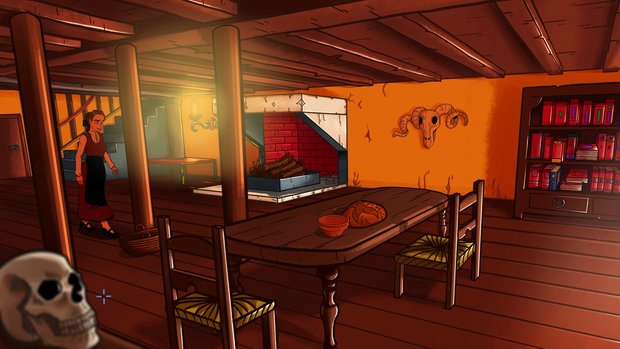
But you can’t do it ALL yourself. Hence the Kickstarter campaign.
Luis: That’s right. In the game, I create the graphics, animation, story, puzzles… almost everything, but there are certain things that I can’t do. If you played the demo, you would discover the game almost as I envisioned the full version, with professional sound design, an original soundtrack composed by a young and talented Polish composer, full localization in English, Spanish, and French, and what I love most: voice-over in English and Spanish.
All these things cost a lot of money, and I wouldn’t be able to afford them by myself, without backing. So I decided to take my chances and launch a Kickstarter campaign that hopefully (fingers crossed) will allow me to cover these expenses.
At the moment I'm writing these lines, the campaign has already reached 73% of its goal, with exactly 7 days to go, and 286 wonderful fans have already backed the project. I’m incredibly thankful to all of them, because they are not only backing my project but also sharing it constantly on social media and with their friends.
Perfect time for this interview, then! How do we help bump you up to 100% and pus hit over the top?
Luis: I’m sure that among your audience there are passionate adventure game fans who might be interested in the game and could find the Kickstarter campaign attractive. If I had a megaphone and I could tell them what's in my campaign and why they should back Legends of Castile on Kickstarter, I’d say that they will find more than just the digital game there. If they love big boxes like the ones we had in the nineties, I have designed one with games like The Curse of Monkey Island or King’s Quest VII in mind, full of goodies like a bestiary/manual, a wooden USB stick with the game and extra digital content, including an art book, and an “Ask me about Legends of Castile” badge.
And if they want more, there’s a collector’s edition of the game with a resin figurine of the protagonist designed by my talented brother, who is a professional sculptor, and also a poster map of the game.
Now, after this shameless piece of promotion, I have to say that I’ve put all my energy and effort into the campaign. Backing the project is very important to make this game a reality. If they like the game, they can support it starting with just a few bucks—every bit counts.
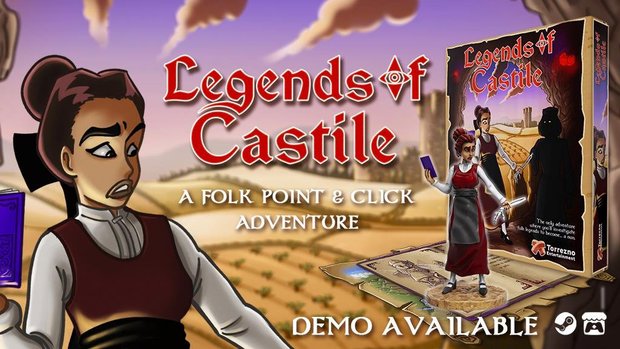
And when – not if – the campaign succeeds, when might we be able to get our hands on Legends of Castile?
Luis: The release of the game is planned for the final months of next year, 2025. I am committed to this timeline if the adventure game community places their trust in me and the goal of the Kickstarter campaign is reached, along with hopefully some stretch goals. These stretch goals will help deliver a better game, including voice-over, extra translations like German and French (the game will be translated into English and Spanish if it’s funded), and even the possibility of petting all the animals in the game!
Well, it’s certainly a lovely game, Luis, so I wish you nothing but the best with the campaign in its final days, and of course with the rest of the project. Can’t wait to see more! Thanks so much for taking time to share your thoughts with us. Before we go, any final words to leave with your readers?
Luis: The pleasure is mine, Jack. Thank you very much for having me here and for your kind words. I hope to be here again on this wonderful website and with this amazing community when the game is closer to its release.


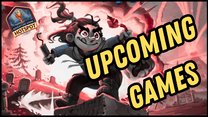

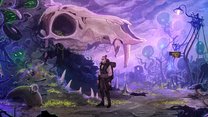
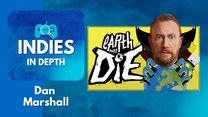
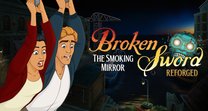



0 Comments
Want to join the discussion? Leave a comment as guest, sign in or register in our forums.
Leave a comment